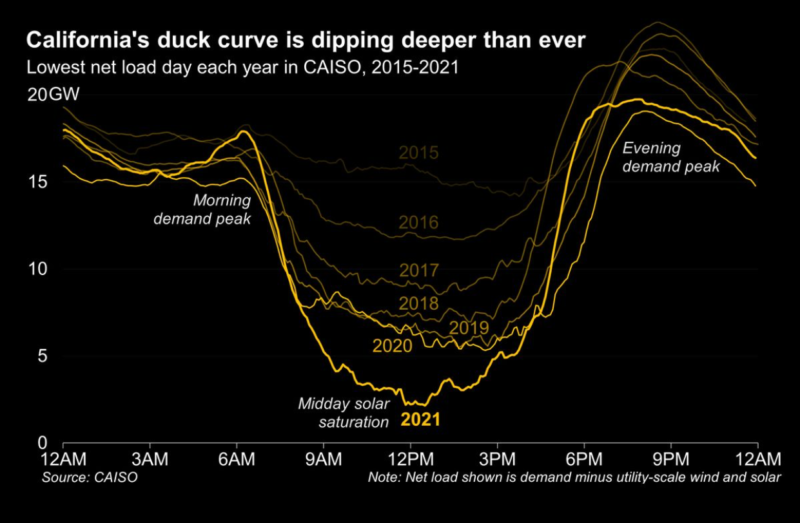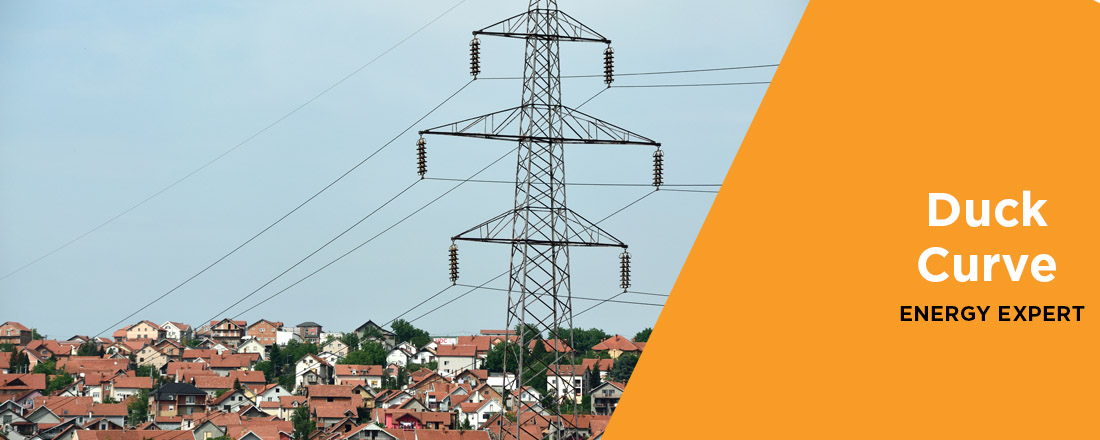MCE’s Energy Expert Series takes a deeper dive into more complex energy topics. Explore topics like this, microgrids, and net energy metering in greater detail through our Energy Expert series. Looking for more basics? Check out our Energy 101 series which covers the basics.
What is the duck curve?
If you’re familiar with the California energy market, chances are you’ve also heard the term “duck curve.” The duck curve is a result of an increase in energy generation in the middle of the day from rooftop solar and utility-scale solar production. Solar energy is the most cost-effective renewable energy technology, and is commonplace across California as a way to lower energy costs and reduce greenhouse gases. Solar panels produce the most energy between the hours of 11 a.m. and 4 p.m when the sun is high. To cover a home or a business’ yearly energy usage, most installations are designed to produce excess electricity during these hours, creating the “belly” of the duck.

As solar production decreases in the evening, the net load experiences a corresponding increase. Solar generation drops off and is replaced by wind, biogas, geothermal, hydroelectric, and natural gas resources. This time period (4-9 p.m.) is known as the “evening ramp”. Customers are returning home, using more electricity, and creating a steep increase in demand while the amount of available solar generation drops dramatically. This usage pattern creates the “neck” of the duck.
As more solar is developed across the state and evening demand for electricity grows, the neck of the duck curve represents arguably the largest reliability issue that California faces today. The state has heavily supported adoption of solar technologies in order for California to reach its greenhouse gas emissions reduction targets, resulting in a large amount of solar production without an optimal method of integrating or storing it. This lack of integration results in several issues: expensive requirements for utilities to reserve generation resources for peak times, curtailment of utility-scale solar during hours of overproduction, and an extremely sharp evening ramp that relies heavily on fossil fuel use.
How does the duck curve impact you?
Load-serving entities like MCE have purchased and developed large amounts of solar and other renewable energy generation to move California toward a clean energy future. In the middle of the day when your rooftop is generating solar, so are hundreds of megawatts of utility-scale solar under contract with MCE. Unfortunately, not all of that energy is always needed during the time of day it’s being generated, resulting in curtailment of utility-scale solar generation.
Solar Curtailment
Curtailment is when energy production from a generation resource is intentionally reduced to better match the grid’s supply and demand needs at a given time. This reduction is most often necessary for utility-scale solar projects. As the thousands of rooftop solar projects across the state send energy back into the grid during the day, utility-scale solar facilities are asked to reduce or even fully stop energy generation. Curtailment increases costs for utilities, since they often still pay for curtailed energy, which can increase customer rates. Although an uncommon occurrence, it is more prevalent each year.
Time-of-Use Rate Transition
California is changing how it charges customers for the energy they use, to better match the supply and demand of available energy and maximize the use of solar. Households are transitioning to time-of-use rates over the next two years, with lower rates for most electricity usage and higher rates during the 4-9 p.m. peak; customers can decline this transition if requested. Businesses that have been served by 12-6 p.m. rates were migrated to 4-9 p.m. peak rates in March and April of 2020.
Time-of-use rates better represent the true cost of electricity during the hours in which it is used. Customers are incentivized to use electricity at times when prices are lower – and when clean energy is more abundant – to help keep bills and greenhouse gas emissions down.
Greenhouse Gas Impacts
The neck of the duck represents the evening ramp and net peak, when solar suddenly goes offline while customer demand is rapidly increasing. While energy service providers try to support this ramp with hydroelectric and other greenhouse gas-free resources, natural gas peaker plants are usually called upon, resulting in carbon emissions. Many of these natural gas facilities operate at around 15% capacity 24-7 to meet these short periods of ramping need. When the evening ramp occurs, these often outdated and inefficient facilities are pushed to go from 15% to 100% generation for just a few short hours.
Grid Reliability
The evening ramp is one major concern when considering the reliability of California’s energy grid. Load serving entities have a regulatory requirement to purchase energy reserves to ensure that customers have access to reliable power. The duck curve makes this harder for providers as the gap between generation and demand widens. Continuing to incentivize rooftop solar deployment without addressing the impact on the duck curve results in reliability issues and higher energy costs, while increasing emissions and making it more difficult for California to reach our 2030 climate goals.
The good news is that simple strategies can help mitigate the duck curve while saving customers money, combating climate change, and increasing energy resiliency.
What is MCE doing to mitigate the duck curve?
Addressing the duck curve means reducing the belly and shortening the neck. Essentially, decreasing the overproduction of solar in the middle of the day and the evening peak demand, while increasing access to renewable resources around the clock. The most effective ways to achieve our goals are by deploying energy storage technologies to smooth out renewable energy production across the entire day and creating behavioral change in consumers to lessen their demand during peak hours.
Energy Storage
Deployment of energy storage technologies is one of the most effective ways to reduce the belly of the duck. To meet state climate goals, we must take advantage of solar overproduction. Distributed and utility-scale energy storage in the form of lithium-ion batteries, green hydrogen, and other technologies allows us to harness and store midday solar production for use during the evening peak, reducing the need for carbon-intensive natural gas plants. Pairing of solar and storage technologies also reduces cost for consumers and utilities, while increasing grid reliability. For residential and commercial customers, batteries can reduce monthly bills while keeping the lights on during an outage.
Behavioral Change
Behavioral change is also necessary, and the state’s transition to time-of-use rates for consumers is reflective of that. You can take advantage of time-of-use rates by moving usage of certain appliances like dishwashers and laundry out of the 4-9p period. If you have an electric vehicle, consider charging it in the middle of the day when solar is pumping, or at night after you’ve gone to bed, instead of right when you get home.
Behavioral changes that transition electricity usage to peak solar hours reduce the belly and shorten the neck of the duck, helping address overproduction issues and ramping concerns simultaneously.
For more information
MCE has a variety of programs that address the duck curve, including our Energy Storage Program, our Demand FLEXmarket program, exploration of green hydrogen solutions, and energy storage requirements for all new solar power contracts. By working together with our customers, we can achieve a carbon-free future while creating more resilient communities. For more information about MCE’s programs visit our programs webpage, and don’t forget to check out the latest in our Energy Expert series.






